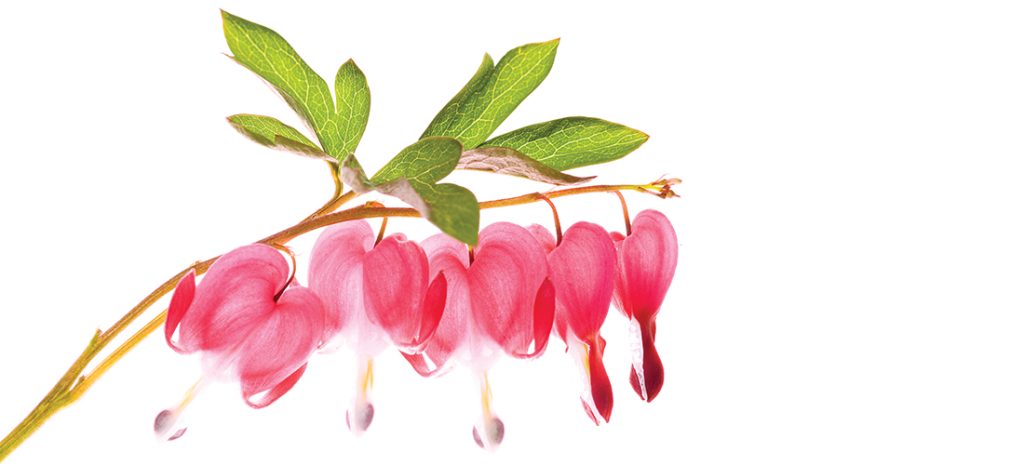Botanicus

Remembrance of Things Past
Old-fashioned bleeding heart
By Ross Howell Jr.
A heart shape signifying romantic love was already a popular symbol on Valentine’s Day cards way back in 1846, when botanist Robert Fortune returned to England after a three-year-long expedition to the Far East.
As a youth, the Scotsman had apprenticed in local gardens, then taken a position with the Edinburgh Botanical Garden. He was serving as a superintendent with the Royal Horticultural Society garden in Chiswick when he was commissioned to search for plants in Asia.
During his trek, Fortune endured shipwreck, pirates and fever, entering China in disguise, since acquiring plant specimens for export to Europe was strictly forbidden.
Among the many plants that Fortune sent home to England were a beautiful tea rose called “Fortune’s double yellow,” a Chinese windmill palm (Trachycarpus fortunei) and a Japanese anemone, along with various tree-peonies, azaleas and chrysanthemums.
Fortune also sent a kumquat (Citrus japonica) and a flowering plant that would become a Valentine’s Day tradition.
Lamprocapnos spectabilis had long been cultivated in the gardens of northern China, Japan and Korea and was also found in the wild.
The bleeding heart.
Fortune had brought to England nature’s living manifestation of the romantic heart, arranged in delicate, pendant rows of red or pink. Later in the 19th century, the bleeding heart made its way into American gardens.
The first blooms I remember seeing grew by the Dutch door that opened from the kitchen to the garden in the mountain farmhouse where my mother was born. The foliage of those plants reached about to my chin, and each pendant heart was considerably larger than my thumb.
The lobed shape of the bleeding heart was so different from other flowers I’d discovered in the fields and woods. They didn’t seem real. Their deep red color was the shade of my mother’s lipstick.
Descendants of Fortune’s Asian plants — like the ones I’m recalling here — have come to be called “old-fashioned” bleeding heart.
Recently I inherited two when my wife, Mary Leigh, and I purchased a townhouse in Blowing Rock.
I noticed them sprouting on a steep, partially shaded bank the first spring we were there. They bloomed feebly. Their foliage faded by early June.
That summer I became friends with one of our neighbors. Turns out, we’re the same age. He’s a cigar-smoking, whiskey-drinking, pacemaker-wearing man with hands like bear paws, a successful entrepreneur, a gifted, self-taught artist, and a curmudgeon.
One day when I was on the bank pruning a rhododendron, my neighbor told me the bleeding hearts had been planted by his wife. She’d passed away suddenly the first night Mary Leigh and I spent at our place. We saw the EMT vehicle but knew no one in the neighborhood at the time and had no idea what had happened. They’d been married for 43 years.
That fall I scattered a little topsoil and layered the steep bank with leaves and hardwood mulch. The following spring, the bleeding hearts answered.
They produced thick foliage that cascaded down the bank with a profusion of pink hearts.
Sometimes from the kitchen window I’d see my neighbor stop to look at the plants when he was out walking his Pomeranian, a gift from his late wife.
A smile came to my face — watching that big, grumpy old man with the fluffy, little dog on a leash, gazing at the bleeding hearts on the bank.
I’m sure he was thinking about his wife. Just as I was thinking about my late mother.
Well done, Robert Fortune.
It’s good to remember those we love and those we’ve loved.
Happy Valentine’s Day! OH
Ross Howell Jr. is a contributing writer to O.Henry. Interested in bleeding heart varieties, old-fashioned or native? Visit the University of Wisconsin-Madison Horticulture Extension www. hort.extension.wisc.edu and the North Carolina Native Plant Society, www.ncwildflower.org.
